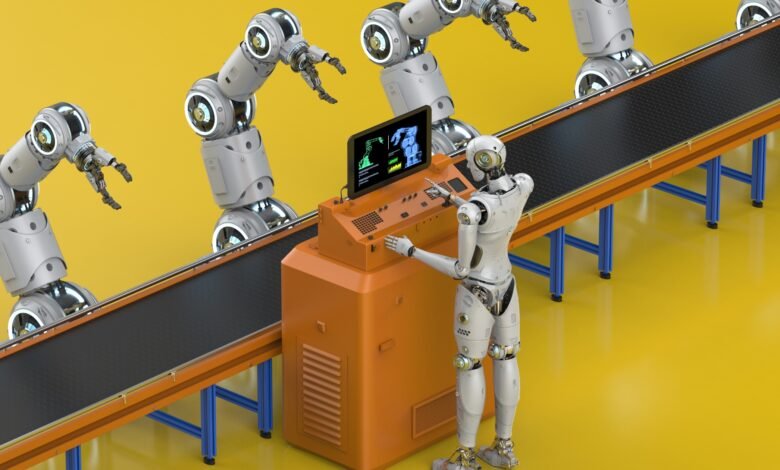Robotics and Automation: Changing the Future of Work

The advent of robotics and automation is reshaping industries, revolutionizing workplaces, and redefining the concept of work itself. These technologies, driven by advances in artificial intelligence (AI), machine learning, and engineering, are not just transforming how tasks are performed but also influencing global economies and workforce dynamics. This article delves into the impact of robotics and automation, their applications, challenges, and the potential they hold for the future of work.
Understanding Robotics and Automation
Robotics involves designing, creating, and deploying robots to perform tasks traditionally done by humans. Automation, on the other hand, refers to the use of technology to execute tasks without human intervention. Together, these technologies are enabling smarter, faster, and more efficient systems across industries.
Robots are no longer confined to manufacturing floors; they now perform complex tasks in healthcare, agriculture, logistics, and even customer service. Automation has expanded into software applications like robotic process automation (RPA), which automates repetitive office tasks such as data entry and invoice processing.
See also: How Wearable Technology Is Enhancing Health and Fitness
Key Drivers of Robotics and Automation
Several factors are fueling the rapid adoption of robotics and automation:
- Advancements in AI and Machine Learning: AI enables robots to learn and adapt, making them capable of handling increasingly complex tasks.
- Cost Efficiency: Automation reduces operational costs by minimizing errors and improving productivity.
- Demand for Speed and Precision: Modern industries require fast and accurate processes that are best achieved through automation.
- Labor Shortages: Robotics addresses labor gaps in industries where human resources are scarce or repetitive tasks deter workers.
- COVID-19 Acceleration: The pandemic spurred the adoption of robotics and automation to reduce human interaction and ensure continuity.
Applications of Robotics and Automation
Manufacturing
Manufacturing was among the earliest adopters of robotics. Automated assembly lines, robotic arms, and AI-driven quality control systems have transformed production processes. These advancements enhance precision, reduce waste, and ensure consistent product quality.
Healthcare
In healthcare, robotics and automation are revolutionizing surgeries, diagnostics, and patient care. Robotic surgical systems provide unparalleled precision, while automation in diagnostics enables faster and more accurate results. Autonomous robots are also used for tasks like disinfecting hospital rooms and delivering supplies.
Logistics and Supply Chain
Automated warehouses, autonomous delivery drones, and self-driving vehicles are streamlining logistics operations. Companies like Amazon use robotics for inventory management and order fulfillment, drastically reducing delivery times.
Agriculture
Automation in agriculture, such as robotic harvesters and drones for crop monitoring, is optimizing resource use and boosting yields. Precision farming powered by AI ensures better crop health and sustainability.
Retail and Customer Service
Retailers are adopting robotics for inventory tracking, shelf management, and even customer interaction. Chatbots and AI-powered virtual assistants automate customer service, providing faster responses and enhancing user experiences.
Construction
Robots in construction perform tasks such as bricklaying, concrete pouring, and inspection with high precision and speed. Automation reduces project timelines and enhances worker safety in hazardous environments.
The Benefits of Robotics and Automation
- Increased Productivity: Automation enables 24/7 operations, maximizing output.
- Improved Safety: Robots perform hazardous tasks, reducing workplace injuries.
- Consistency and Quality: Automated systems deliver uniform results with minimal errors.
- Cost Savings: Businesses save on labor costs and minimize losses due to human error.
- Enhanced Innovation: Freed from repetitive tasks, workers can focus on creative and strategic activities.
Challenges and Concerns
While the advantages are evident, robotics and automation present challenges that need addressing.
- Job Displacement: Automation of repetitive tasks raises concerns about unemployment in sectors like manufacturing and retail.
- High Initial Costs: Implementing robotics requires significant investment in technology and training.
- Cybersecurity Risks: Automated systems are vulnerable to hacking and cyberattacks, threatening data security.
- Ethical Considerations: The growing use of AI raises ethical questions about decision-making and accountability.
- Skills Gap: Workers need upskilling to adapt to technology-driven roles, creating a need for robust training programs.
Emerging Trends in Robotics and Automation
Collaborative Robots (Cobots)
Cobots are designed to work alongside humans, enhancing productivity while maintaining safety. They are increasingly used in industries like manufacturing and healthcare.
Autonomous Systems
Self-driving vehicles, delivery drones, and autonomous robots are becoming integral to logistics and transportation, offering faster and more efficient solutions.
AI Integration
AI-powered robotics are capable of learning from data, making them more adaptable and intelligent over time. This trend is driving innovation in sectors like healthcare and customer service.
Robotics-as-a-Service (RaaS)
The RaaS model allows businesses to lease robotic solutions rather than investing heavily in purchasing them. This trend is making automation accessible to smaller enterprises.
Sustainability in Automation
Green robotics and eco-friendly automation practices are gaining traction, addressing environmental concerns while maintaining efficiency.
Preparing for the Future of Work
As robotics and automation redefine work, preparing the workforce for this transformation is crucial. Companies must invest in upskilling employees, focusing on skills that complement automation, such as critical thinking, creativity, and emotional intelligence.
Governments and educational institutions also play a vital role by introducing STEM (science, technology, engineering, and mathematics) programs and vocational training. Policies supporting workforce transition, including retraining initiatives and social safety nets, are essential to mitigate job displacement.
The Role of Robotics and Automation in Shaping Industries
Industries are leveraging robotics and automation to drive innovation and competitiveness. The manufacturing sector benefits from faster production cycles, while healthcare enjoys better patient outcomes through robotic assistance. Agriculture, logistics, and retail are experiencing unprecedented efficiency and scalability.
Automation is also creating entirely new industries, such as robotic process automation services and AI-driven startups. By embracing these technologies, businesses can position themselves at the forefront of their respective markets.
Conclusion
Robotics and automation are not just changing how work is done; they are redefining the very nature of work. While challenges like job displacement and ethical concerns exist, the benefits far outweigh the risks. From manufacturing to healthcare, these technologies are enabling unprecedented levels of efficiency, safety, and innovation.
The future of work will be a collaborative effort between humans and machines, with technology handling repetitive tasks while humans focus on creativity, strategy, and empathy-driven roles. By embracing robotics and automation, businesses and individuals alike can unlock a future of endless possibilities.
FAQs
1. What is robotics and automation?
Robotics involves creating robots to perform tasks, while automation uses technology to execute tasks without human intervention. Together, they enhance efficiency and reduce manual effort.
2. How is automation affecting jobs?
While automation can displace certain roles, it also creates new opportunities in technology-driven industries and demands upskilling for workers.
3. What industries benefit most from robotics?
Manufacturing, healthcare, logistics, agriculture, and retail are among the top sectors benefiting from robotics and automation.
4. What are collaborative robots?
Collaborative robots, or cobots, are designed to work alongside humans, enhancing productivity and ensuring safety.
5. How can businesses prepare for automation?
Businesses can prepare by investing in employee training, adopting scalable automation solutions, and focusing on roles that require human creativity and critical thinking.
6. What is Robotics-as-a-Service (RaaS)?
RaaS allows companies to lease robotics solutions instead of purchasing them, making automation more accessible and cost-effective.




